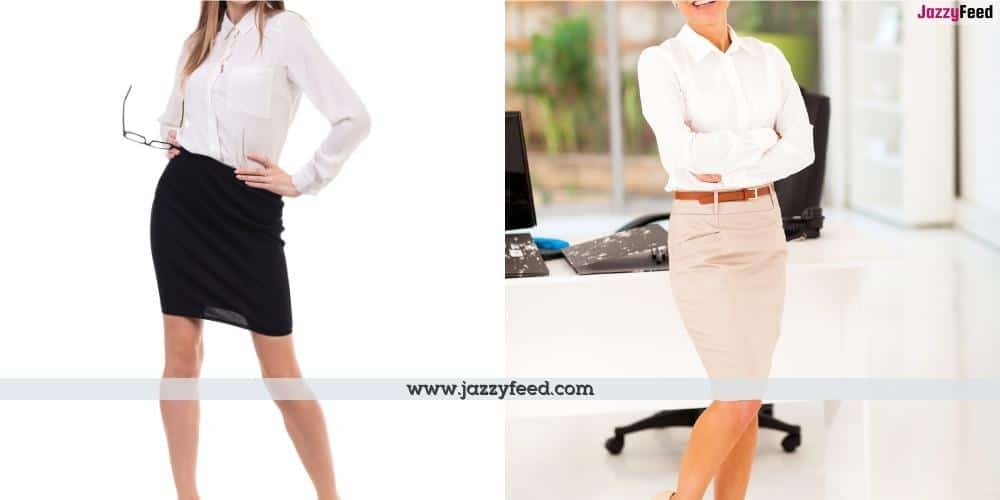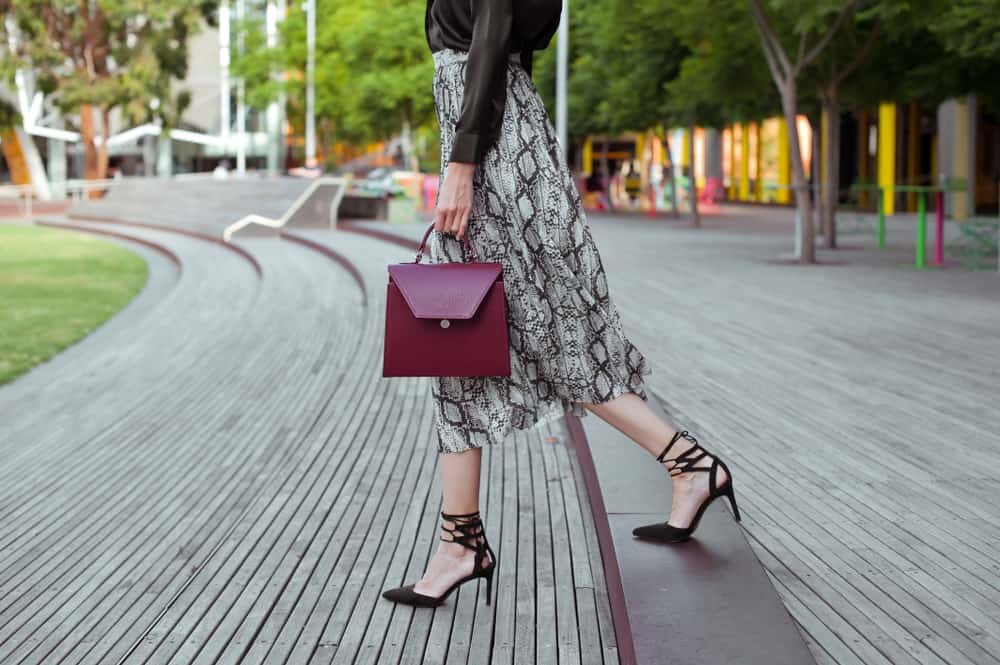If you’re new to the corporate world, you might be wondering what constitutes a business casual dress code. Or maybe you’ve been working from home for over a year and have completely forgotten what is suitable at the office! We’ve got all your questions and worries handled, especially when it comes to skirts, where length and fit may play such an important role in whether they’re judged appropriate in the workplace.

There is no black-and-white answer to whether skirts are appropriate for business casual. They can be if they’re the right length, fit, and style, but they can’t be if they’re not. Pencil skirts that are knee-length or split at the knee or below and allow you to sit comfortably in public are considered business casual.
Like fashion in general, this can leave a lot to interpretation, personal style, and personal tastes. We’ll walk you through everything so you don’t make any fashion faux pas in front of your coworkers.
Many of us ask if skirts are business casual while putting together our work wardrobes, and if so, which designs of skirts suit the criteria. With so many various styles of skirts to choose from, it can be difficult to know which ones are appropriate for the workplace and which should be kept completely casual. To assist you, I’ve put together a business casual skirt guide that covers as many different styles of skirts as possible, as well as fashion ideas and inspiration for easy work ensembles.
What is the Right Length for Skirts for Work?
Of course, this is dependent on a variety of elements, such as body proportions (longer or shorter arms), the type of dress or skirt (if it flares at the end, you can add another inch or two), and the office dress code (business professional dresses and skirts should be even longer than business casual attire).

Make sure your dress or skirt isn’t shorter than two inches over your knee, whether you’re tall, short, or medium height. Even more formal business dress is required. I’d make sure the dresses and skirts you’re wearing aren’t any shorter than an inch above your knee. I’m wearing a dress that stretches out at the bottom. I add an inch or two to them since the dress will lay flat and be long enough in the workplace, but the breeze will push it up a little outside!
I cheat a little bit with skirts (after all, I am 5’11), but I always make sure that the skirt is at least 3 inches over my knee! Do you have any doubts about what two inches look like? To check yourself, get a ruler or download a ruler app.
Now put on your favorite work dress, which you once thought was too short. WARNING: IF YOU THINK THE DRESS IS TOO SHORT, YOU ARE RIGHT. It is especially difficult for women to be taken seriously at work and to be treated equally with males. If you wear short dresses and skirts, you are putting yourself, as well as the rest of us, further behind. Being properly attired demonstrates ambition! Before you go out tomorrow, double-check that your clothing is the appropriate length.
Are Skirts Appropriate for Work?
Your mother probably told you not to wear a short skirt to work, but you can toss that bit of 1960s fashion advice, along with the rest of the outdated fashion standards, out the window. Above-the-knee hemlines are fashionable this season, and they may entirely work appropriately in certain (the keyword being certain — I don’t want to be blamed for any HR transgressions) offices if coupled with the right tops and footwear. Keep your heel low or use tights and boots to give more coverage below the waist when wearing tiny skirts to work.
To balance the leggier look, use more modest necklines above the waist. Of course, micro-minis will never be appropriate for the office, at least in my opinion, so I recommend sticking to a skirt that is cut just above the knee. Having said that, there are specific offices and types of employment where tiny skirts are unlikely to be acceptable. I am a great believer in wearing what you want rather than what others tell you to wear. However, the world does not always operate that way, and it may be worthwhile to adhere to the corporate dress code in order to maintain the focus on work at least until you reach the C suite and are able to rewrite the rules.
Are Skirts Considered Business Attire?
When properly designed for an office environment, skirts are called business casual wear. Short, vividly patterned, or brightly colored skirts should be avoided and should be paired with other working items such as a fitted blazer.

Here are some simple guidelines to follow when selecting a skirt for a business casual dress code:
- Consider a style with a longer hemline, such as a midi or just above the knee length. Avoid anything too short, since it will err on the side of being too casual.
- Bright patterns and colours, such as neon, should be avoided because they will appear too casual. Instead, go with muted colours and basic patterns like polka dots or a delicate floral.
- Choose a high-quality office-appropriate fabric, such as wool, tweed, black denim, or suit material. Avoid using silk or tulle because they appear overly formal.
- If in doubt, choose a more modest skirt type (such as a classic A-line), and avoid thigh slits, graphic patterns (such as owls or cats), or any branded text on the garment.
If you’re wearing a more ‘casual’ skirt, like black denim or a summery midi skirt, be sure the remainder of your ensemble qualifies as ‘business’ attire.
Feel free to wear your more casual skirt as long as it adheres to the aforementioned cut, pattern, and color guidelines, but make sure the rest of your outfit is smart. Wear the skirt with a lovely top, heels or stylish black ankle boots, and a blazer or tailored jacket.
If the skirt is both casual and smart, feel free to match it with additional pieces that fall into the same category. The two outfits I dressed below with a business casual dress code in mind are a perfect example of this:
Both of the aforementioned skirts may be classified as business casual because they are formal enough to be considered workwear yet loosened enough to be deemed casual when worn with a t-shirt.
To stretch my legs and keep the bottom half of the outfit subdued, I matched both skirts with elegant black tights and sleek heeled ankle boots. Both skirts have a black pattern, which adds a touch of refinement and allows them to be easily paired with dark tights.
Simple turtlenecks were chosen for the upper half of the ensemble because they are conservative enough to be considered business casual as well. Simple colors like plain white or dusty pink work well for business casual clothing since they complement the design on the skirt without bringing too much attention to themselves.
I’d add court heels instead of ankle boots and a tailored cropped jacket on top to spice this ensemble up even further. I’d replace the tights and black boots with a basic pair of heels, and the turtlenecks with a light cream blouse for the summer.
Keep your accessories to a bare minimum and complement them with a stylish handbag.
Now that we’ve covered the fundamentals, let’s look at other sorts of skirts and see if they’re appropriate for this dress code.
Are Skirts Business Casuals?
They certainly can be. The more important question is: which skirts are appropriate for business casual? This is a trickier question to address. There are several aspects of the skirt that must be perfect in order for it to be considered business casual. We’ll take a look at each one separately.
Choose the Right Length for the Skirt
As a general rule, the first criteria of a business casual skirt is its length, and anything too short, regardless of design or fabric, is immediately regarded improper. Thus, the length of the skirt is the most important factor in determining its business casualness! Anything above or below the knee, as well as anything with a slit starting at the knee, is acceptable.
Anything above the knee in a standing position is too far up the thigh to be regarded fit for employment.
Choose the right Style for the skirt
When it comes to skirt styles at work, pencil skirts are a safe and classic pick. This is not, however, the sole suitable business casual style. Whether it’s a-line or flared, pleated or flowy, the style of the skirt doesn’t matter as much as the fit and the rest of the outfit.
It should be fine as long as the skirt fits you nicely (i.e., it is not too tight or too loose). To keep your look neat and professional, wear something close-fitting but not too tight.
choose the right Fabric for the skirt
While fashion trends come and go, and satin might be worn in the bedroom one year and on the streets the next, there are certain broad guidelines for what is appropriate for the workplace. Satin, for example, is not considered business casual in general. Denim, tulle, anything sheer, spandex, and anything really flashy is also no-nos.
A woven cloth or wool in a medium to heavyweight is usually an excellent choice. Avoid anything that is light, see-through, or clinging.
There are certain grey areas, as there always are, that will be determined by the type of business culture you have. A metallic pleated midi skirt paired with a collar and proper shoes may easily be deemed business casual if you work at a startup, a very young company, or anyplace that is normally informal but requires business casual for client meetings. Metallic is unlikely to be considered appropriate if you wear the same clothing to a bank or a financial or legal organization.
In some workplace contexts, a below-the-knee-length leather pencil skirt may appear completely suitable as business casual when worn with a fresh white shirt, but not in others.
choose the right Color for the skirt
Bright, strong patterns and anything that attracts attention to yourself have traditionally been frowned upon as part of a professional outfit. There’s some leeway with a business casual look here, but if you’re unsure, go to more neutral hues with an even tone or two-tone throughout the skirt. If you want to be safe, stick to black, brown, caramel, navy, dark green, burgundy, or grey.

